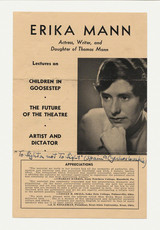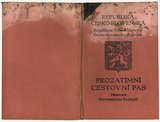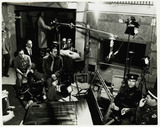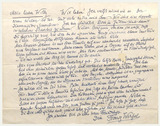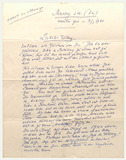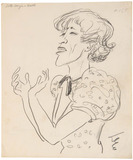Flyer for lectures by Erika Mann (1938)
Erika Mann's career as a lecturer or public speaker began on 15 March 1937 before approximately 23,000 people at Madison Square Garden. Billed at the rally of the American Jewish Congress as an "exiled German playwright", Erika Mann read a greeting telegram from her father Thomas Mann and spoke on the subject of "Women in the Third Reich".
Forged carte d’identité for painter Leo Maillet (early 1940s)
This forged French identity document, made out in the name of Théodore Maillet, helped painter Leopold Mayer escape from France to Switzerland. After narrowly escaping extradition to the German-occupied zone in the autumn of 1942, from where he would have been deported to Auschwitz, Mayer had to go into hiding in the south of France, where he used a false name and worked as a shepherd in the Cévennes.
Forged passport of Iwan and Charlotte Heilbut (1940)
A Czechoslovakian consul as escape agent in FranceThe Czechoslovakian Consul in Marseilles, Vladimír Vochoč, who effectively represented a country which no longer existed, helped numerous people to flee France with forged passports. They included Heinrich Mann, who travelled with one of these passports under the false name of Heinrich Ludwig.
Four in a Jeep (1951)
Hans Sahl’s collaboration on the scriptThe author Hans Sahl suffered from a lack of money and also a lack of professional prospects in exile in America. He was therefore very glad to receive the offer to collaborate on the screenplay of a Swiss film production.
Franz and Alma Werfel: Letter to Albine Werfel (23 July 1940)
“Please write only my second name”Letters Franz Werfel and his wife Alma Mahler-Werfel sent to Werfel's parents accompany their road into exile in the years 1938 to 1942 without mentioning the hardships, hunger and constant fear. Instead, in this letter from 23 July 1940, the lines bespeak the intimacy within the family: “It is still impossible to know anything, to foresee anything.
Franz Werfel: Letter to Else Lasker- Schüler, 1936
The author Franz Werfel wrote this letter to the poet Else Lasker-Schüler a few weeks after his first trip to the United States, where he was welcomed and celebrated as a famous author. With awareness to the meaning of the above mentioned citation – the loneliness and encumbrances of the exiled – Werfel returned to his politically-divided homeland, Austria.
Franz Werfel: Letter to Willy Haas (20 January 1941)
“My dear Willy we're alive!”Writers Franz Werfel and Willy Haas had known each other since their school days in Prague. In exile, they were separated by the distance between India and the south of France.
Franz Werfel: Letter to Willy Haas (January 1940)
“Word from you at last!”This was the first letter that Franz Werfel wrote, in 1940. He sent it from Sanary-sur-Mer to his friend Willy Haas in India. The two writers had been close since their shared schooldays. Now they were separated by exile and distance.
Fred Dolbin: Drawing of Bertolt Brecht and Kurt Weill (presumably 1935)
Bertolt Brecht and Kurt Weill began working together in the late 1920s. From their collaboration came pieces such as the Dreigroschenoper (The Threepenny Opera) and the ballet Die sieben Todsünden (The Seven Deadly Sins).
Fred Dolbin: Drawing of Lotte Lenya at rehearsals (1936)
At the start of 1936, cartoonist Benedikt Fred Dolbin produced a series of sketches at the rehearsals for Kurt Weill’s oratorio The Eternal Road – Der Weg der Verheißung. It was a rewarding assignment for the illustrator, as the premiere of the work had a cast of 60 main actors, 30 dancers and a large choir.
